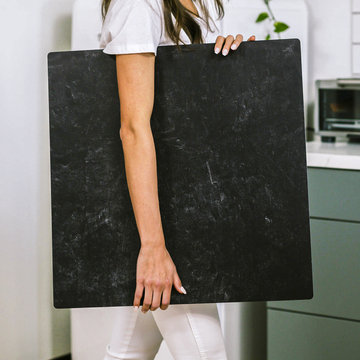After fifteen years of crouching behind cameras and obsessing over lighting setups, I've come to an unexpected conclusion: the unsung hero of product photography isn't my $3,000 camera or collection of premium lenses-it's the humble background board that's revolutionized my workflow and image quality.
That matte surface with the perfect gradient might look simple, but trust me, there's sophisticated engineering happening beneath that unassuming exterior. Let me take you behind the scenes of what might be the most underappreciated tool in your photography arsenal.
Not Just a Pretty Surface: The Science Behind Background Boards
When clients visit my studio, they often point to my collection of background boards and ask, "Couldn't I just use colored paper?" I usually respond by showing them two identical product shots-one using premium board, another using standard paper. The difference is striking, but the reason isn't immediately obvious.
Modern professional background boards are sophisticated multi-layer constructions. The core typically consists of high-density polyethylene, compressed PVC, or engineered wood fiber, providing stability without excessive weight. This foundation is then covered with specialized surface materials specifically designed for optimal light interaction.
Ever notice how some backgrounds make your products "pop" while others fall flat? The magic lies in the surface reflectance profile. Premium boards feature micro-textured finishes that diffuse light in controlled ways, eliminating hot spots while maintaining true color reproduction regardless of your lighting setup.
The Light Dance: How Backgrounds Transform Your Lighting
Last month during a jewelry shoot, I switched from standard paper to a professional-grade background board mid-session. The client immediately noticed the difference-suddenly the diamonds had that crisp, clean sparkle against a perfectly smooth gradient. What happened? The physics of light interaction changed dramatically.
When light hits your background, three things happen simultaneously:
- Some light bounces back directly (specular reflection)
- Some scatters in multiple directions (diffuse reflection)
- Some is absorbed and converted to heat
The best background boards are engineered with specific reflectance ratios optimized for photography. For product work, I choose surfaces with 85-90% diffuse reflection and minimal specular reflection, creating those soft, gradient shadows that make products look three-dimensional and luxurious.
Pro tip: Want to test your backgrounds? Shine a focused light at a 45-degree angle onto different surfaces and observe the reflection pattern. The difference between budget and professional backgrounds becomes immediately apparent!
From One-Trick Ponies to Versatile Workhorses
Remember the days of storing dozens of paper backdrops that would tear, crease, and fade after a few uses? My studio closet was a graveyard of rolled-up, damaged backgrounds. Today's advanced photography surfaces have completely transformed my workflow and storage needs.
Modern backgrounds function as complete photographic systems. They're engineered with:
- Structural rigidity that allows positioning at any angle
- Precisely calculated edge curvatures that eliminate visible seam lines
- Color science that maintains accuracy under various lighting conditions
Companies specializing in photography surfaces have pioneered this multi-functional approach. Recently, I completed an entire lifestyle product campaign using just three different surfaces, shooting from morning to evening under changing light conditions with remarkably consistent results.
The Invisible Technology Behind Today's Best Backgrounds
What truly separates professional-grade background boards from basic options is the material science you'll never see-but your camera certainly will capture.
The latest generation of photography backgrounds incorporates:
- Color that goes all the way through: Unlike painted surfaces, premium boards integrate color throughout the material, so scratches and wear don't reveal different colors underneath
- Invisible protective coatings: Nano-scale hydrophobic barriers repel liquids while remaining completely transparent-a lifesaver when shooting food or beverages
- Heat resistance: Special compounds prevent warping even under hot continuous lighting
During a recent beverage shoot, I accidentally spilled coffee on my premium background. Instead of being absorbed and ruining the shoot day, the liquid beaded up and wiped away cleanly. The client was impressed, and we continued without missing a deadline-or my sanity.
What's Next: Smart Backgrounds for the Digital Age
The evolution of background technology shows no signs of slowing. At a recent photography trade show, I saw prototypes with features like:
- Surfaces with embedded patterns invisible to our eyes but detectable by AI-based editing software
- Materials designed to provide spatial reference data for automated product photography
- Backgrounds engineered specifically for virtual production and augmented reality applications
For creators working in e-commerce or social media content, these advancements will make it even easier to produce professional-quality images efficiently and consistently.
Why This Matters for Your Photography
I've seen countless photographers transform their image quality simply by upgrading from improvised backgrounds to properly engineered surfaces. The investment pays dividends in time saved during shooting and editing, not to mention the immediate improvement in image quality.
Last year, I mentored a startup founder who was struggling with her product photography. Her innovative skincare line looked amateur in photos despite using a decent camera. The culprit? She was shooting on colored construction paper. After switching to proper photography backgrounds, her social engagement increased by 47% within a month-same products, same camera, dramatically different results.
The evolution of the humble background board represents something bigger: how technical innovation democratizes professional photography. Capabilities that once required expensive studio setups are now accessible to independent creators working from home offices, kitchen tables, and small spaces.
What backgrounds have transformed your photography? I'd love to hear about your experiences in the comments!
About the author: Alex Reynolds is a commercial product photographer with over 15 years of experience working with brands across fashion, food, and consumer electronics industries. When not in the studio, Alex leads workshops helping small businesses improve their product photography and visual storytelling.



